 |
Castello San Giacomo
Favignana, Italy
|
|
 |
Constructed: Begun in 1498
Used by:
Aragon, Spain, France, Italy
Conflicts in which it participated: None
|
Favignana is an adorable, vaguely moustache-shaped island about four miles off the west coast of Sicily. 'Twas initially named Αιγουσα, Aigousa, Greek for "has goats," but the goats must have moved on in their worldwide conquest by the time the Romans showed up, as those Romans gave the island its present name, which derives from the Latin favonius: a hot wind falling from the west. |
 |
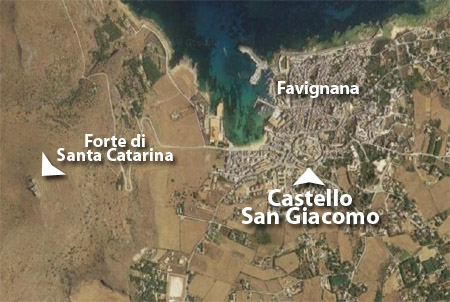 |
|
Human habitation on the Isloa di Favignana dates back to the Upper Paleolithic (50,000-10,000BC), before there even were goats. One of the three (or maybe four or five) Egadi islands, the Phonecians existed there for several hundred years until the Romans destroyed the Carthaginian fleet in the Battle of the Egadi Islands in 241BC. Sicily, and with it the little island of our current interest, became part of the Roman Empire.
Which made it part of the Glorious Vandal Empire when Rome fell in the 5th century; then the Fantastical Goth Confederation of Awesomeness; then the Bodacious Byzantine Empire; then the Most Holy Saracen Horde, blessings be unto it. There can't have been much left of Favignana by the time the Normans, led by Roger I of Sicily (1040-1101)(who was probably not known as Roger I of Sicily before he conquered Sicily) descended upon it in 1081, but whatever was there (the last two remaining goats, perhaps) was deemed important enough to protect by way of fortification.
The Normans built the fortification that would eventually morph into today's Castello San Giacomo, as well as a fort atop Santa Catarina Mountain, less than a mile to the west. This construction process lasted from 1074 to 1101.
|
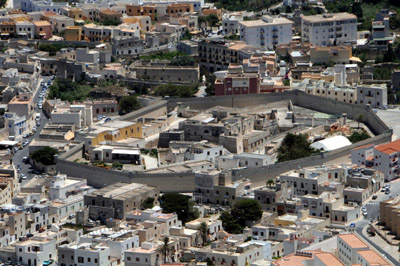 The Castello certainly does look more institutional from this angle. But then a high wall around everything will have that effect. The Castello certainly does look more institutional from this angle. But then a high wall around everything will have that effect. |
 |
The Crown of Aragon had supplanted the Normans in Sicily by the 14th century, its power eventually spanning eastern Spain, southern Italy, and everything in between. It was the Aragonians who built the first starfort on Favignana, beginning in 1498. Which would have made the Castello San Giacomo a very early starfort indeed! The first starfort worthy of the name had leapt into being around 1487 (this is assuming that the first starfort was the Fortezza di Sarzana, which may or may not actually be the case), and only twelve years later one was being built on tiny, relatively unimportant Favignana? Mind-bogglin'. |
|
|
This starfort was built at the tail end of the First Italian War (1494-1498), and would have been thus sited to defend Favignana from the wicked French, whose aggression in the region had arguably caused this conflict. Also, the ports and beaches of Sicily during this period are said to have had an "infestation" of Turks, never good for a potential vacation spot's property values, and a good starfort is an excellent way to both project power and help stamp out those pesky infestations.
The fort's name, San Giacomo, translates as Saint James, one of Jesus' Twelve Apostles, and patron saint of Spain.
Aragon existed at the whim of the fickle system of weird aristocratic intermarriage and eternally squabbling monarchs that defined Europe for many centuries. Though it had a good run, Aragon had pretty much been absorbed by the Habsburg monarchy of Spain by the end of the 16th century, which in turn came under the lurching sway of the Bourbon monarchy thanks to the heirless demise of the spectacularly stunted Spanish King Charles II (1661-1700).
|
The Treaty of Savoy (1713) gave Sicily to the House of Savoy, a northern Italian power, but they decided they'd rather have the island of Sardinia instead, and thus traded with Austria in 1720. Austria allowed its attention to wander during the War of Polish Succession (1733-1735), of which Spain's King Charles III (1716-1788) was more than happy to take advantage, and Sicily was snapped up by Spain.
It's possible that none of these parties had any interest whatsoever in the dumb little islands off of Sicily's west coast, but we're trying to keep up with whom was notionally in charge of Favignana here, and technically, he who was running Sicily was also running the Egadi Islands.
|
 |
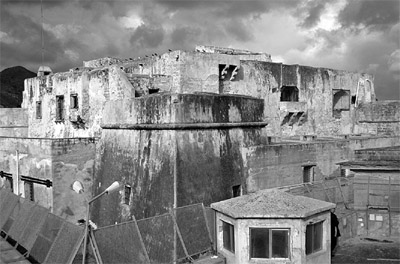 The Castello San Giacomo today, looking particularly sinister. Photograph by Bebo Cammarata and/or Renato Pantaleo, from a 2013 exhibit in Favignana that illustrated the evil, decrepit state of the facility. The Castello San Giacomo today, looking particularly sinister. Photograph by Bebo Cammarata and/or Renato Pantaleo, from a 2013 exhibit in Favignana that illustrated the evil, decrepit state of the facility. |
|
The fort itself is the standard square interior with four bastions: This portion of the fort, for some reason, "represents the male." The larger triangular bastions (oversized ravelins?) on either side of the central fort would therefore represent the...female? Female what? Whatever, the lower portion of the Castillo was cleaved from rock, and it was in this protected space that ammunition was kept, and the garrison was also meant to reside, safe from any attack.
|
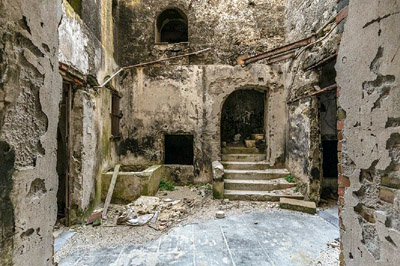
The interior of the Castello San Giacomo, which was utilized as a maximum security prison until 2011. |
 |
The Castillo was surrounded by a moat, over which there were two drawbridges: One of these remains the fort's entrance today, and the other connected the "male" part of the fort with "the rest of the fort." The moat, also hacked from the island's rock, is upwards of thirty feet deep.
When the Bourbons came to be in charge of this marvelous facility, they foresaw that its use would be more incarceratory than defensive. The Castillo became a prison, which role it would unhappily fulfill for the next 300 years. Almost immediately the fort was filled with those in need of incarceration, leaving no room for those lucky men tasked with their oversight. |
|
|
"Dormitories" were carved from the rock walls of the fort's moat, which housed the prison's guards and other "servants of punishment." And what luxurious apartments they must have been, gloomy and humid thanks to the island's tuff, a form of volcanic rock that holds water just as efficiently as it makes everyone trying to exist nearby miserable. More of these really-good-idea holes were later dug in the walls at the base of the moat, for additional prisoner housing. One wonders at what point the guys in charge might have said, "Y'know what? Digging more holes in the rock is silly, let's just make a real jail for these poor schlubs!"
|
The Isloa di Favignana had a successful tuna industry for a while, and was a supplier of tuff as a building material to those who wanted it, but its real mission from the Bourbon days through Fascism in the 20th century and up to 2011, was to serve as a big ole jail island for whomever was in charge of Sicily.
Modern defenses were added around the island during the Second World War (1939-1945), but the Allies likely caught one whiff of what several thousand guys imprisoned in a starfort and little holes carved in the rock around it smelled like, and decided that invasion wouldn't be worth the unpleasantness. You would never be able to get the stench out of your uniform and web gear.
|
 |
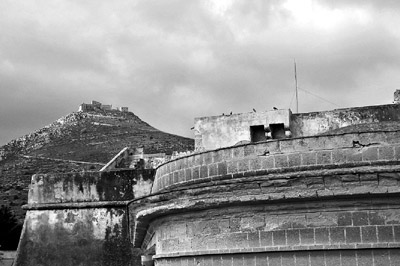 Particularly painful for inmates at the Castillo San Giacomo must have been this view, of the nearby Forte di Santa Caterina. "Why couldn't I have been incarcerated in that cool fort?!" Particularly painful for inmates at the Castillo San Giacomo must have been this view, of the nearby Forte di Santa Caterina. "Why couldn't I have been incarcerated in that cool fort?!" |
|
Eventually, social mores evolved to recognize that even prisoners deserve some level of hygene and self-respect. A new prison was built on Favignana, and the last inmates left the Castillo San Giacomo in 2011. Hideously, this new prison didn't have sufficient housing for its employees, and from what I can divine on the Internet the guards for the new prison are still living in the Castello as of 2018. I can't even.
In 2013 an exhibit called The Invisible Castle, featuring the work of Favignanian photographers Bebo Cammarata and Renato Pantaleo, highlighted the miserable conditions at the Castello. Prisoners and guards alike were illustrated as victims of a state that, for budgetary reasons, allowed the prison to remain in operation for so long after having been universally recognized as ridiculously inhumane.
And I must say, a starfort's story has never made me this unhappy before! Sure, it's not the Castillo's fault that it was used in this capacity for about 150 years longer than it should have been, but...hopefully my faith in starfortery can be restored by...
|
|
|
|
The current Forte di Santa Catarina, which was named for someone named Catherine (who might have been Catherine of Siena (1347-1380), patron saint of Italy...but could just as easily have been Catherine of Alexandria, who was martyred at the hands of wicked pagans in the 4th century), was built around the same time as the Castello San Giacomo (1498-ish), and by the same folks (the arrogant Aragons). Also like the Castillo, the Forte was a standard four-bastioned pointyfort, with two drawbridges connecting the fort to the wider world over a deep moat. A lower level was carved from the rock beneath, which was also used to imprison enemies of the current administration.
|
Inscriptions still (barely) visible on the fort's walls indicate that restoration work was completed in 1616 and 1655, at which time the Spanish would have been doing the restoring...or more likely their prisoners, because why would the Spanish be doing any of the work? Many hundreds of prisoners spent time incarcerated in the Forte.
The Forte di Santa Catarina was severely damaged in 1860 by anti-Bourbon rebels, it being the period in which Italy was struggling towards actual statehood. Happily, Sicily became part of the Kingdom of Italy in 1861, and the Forte's days as a prison were over.
|
 |
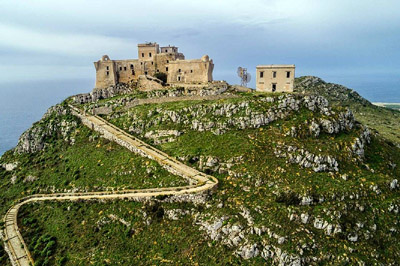 The fort at the top of the hill. Happy climbin'! Hope you're not pregnant! The fort at the top of the hill. Happy climbin'! Hope you're not pregnant! |
|
The Italian Navy took possession of the Forte di Santa Catarina after the Second World War. The Navy was still tending to the fort somewhat at the end of the 1950's, but not long thereafter it was abandoned completely. Recent visitors report that the Forte is in pretty sad shape, but thanks to a recent competition called Art Prison, budding architects are invited to reimagine the Forte di Santa Catarina as an "open-air contemporary art space." Whom exactly is expected to climb all those steps to see open-air contemporary art? Well I would, but I wouldn't be risking a heart attack for the art.
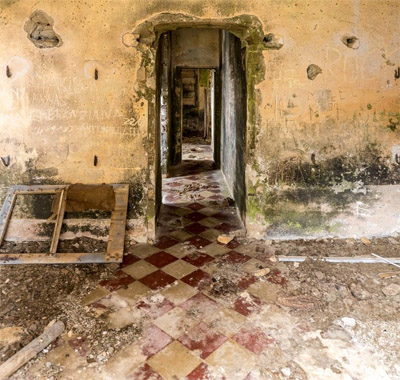 The interior of the Forte di Santa Catarina today, which looks plenty artistic as it is! The interior of the Forte di Santa Catarina today, which looks plenty artistic as it is!
|
|
|
|
|
|
 |




